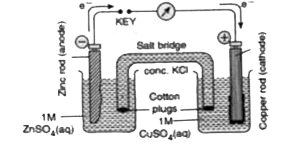Saved Bookmarks
| 1. |
What is galvanic cell ? Discuss briefly with one example. |
Answer» Solution :The device in which electrical energy is produced from chemical reactions is called galvanic cell. The common galvanic cell is a Daniel cell. It consists of two beakers containing 10 M solution of `ZnSO_(4)`, and 1.0M solution of `CuSO_(4)`. A ZINC rod is dipped into `ZnSO_(4)` solution and a copper rod is dipped into `CuSO_(4)` solution. These rods act as electrodes. The solution in the two beakers are connected by inverted U tube containing concentrated solution of some electrolyte such as `KCI, KNO_(3)` or `NH_(4)NO_(3)`. The two openings of the U tube are plugged with some porous material such as glass wool or cotton.  The U tube which connects the two glass beakers is called salt bridge. Salt bridge completes the cell circuit and increases the life of the cell. The arrangement is shown in Fig. When the two electrodes are connected through a voltmeter, the flow of electric current through external circuit is indicated by the voltmeter. The cell formed is called galvanic or voltaic cell. The potential difference is due to the contribution of two half cells. At zinc electrode, zinc is oxidised to `Zn^(2+)` ions which go into the solution. The electrons released at zinc electrode move towards the other electrode (copper) through the outer circuit. These are accepted by `Cu^(2+)` ions of `CuSO_(4)` solution which are reduced to copper. Thus, OXIDATION occurs at zinc electrode and it is called anode. REDUCTION occurs at copper electrode and it is called cathode. The reactions may be represented as : At anode : `Zn(s)toZn^(2+)(aq)+2e""` (oxidation) At cathode : `Cu^(2+)(aq)+2etoCu(s)""` (reduction) The overall cell reaction is `Zn(s)+Cu^(2+)(aq)toZn^(2+)(aq)+Cu(s)` The reactions occurring at anode and cathode are ALSO referred as oxidation half cell reaction and reduction half cell reaction. The cell may be represented as : `Zn(s)|Zn^(2+)(aq)||Cu^(2+)(aq)|Cu(s)` Anode (-) Cathode (+) |
|
Discussion
No Comment Found
Related InterviewSolutions
- Which of the following compounds is not cleaved by HI even at 525 K ?
- To a 25 mL H_(2)O_(2) solution excess of an acidified solution of potassium iodide was added. The iodine liberated required 20 " mL of " 0.3 N sodium thiosulphate solution Calculate the volume strength of H_(2)O_(2) solution.
- The suggested mechanism of a reaction is : (a) A+BhArrD("fast) "(b)A+Drarr2C("slow")Write the balanced equation of the reaction if its experimentally deduced rate equation is , rate k=[A]^(2)[B] Find the intermediate formed during the course of the reaction . Does the predicted rate law from the mechanism match the experimental rate law ?
- Which of these changes with time for a first-order reaction A Rate of reaction B . Rate constant C . Half-life
- What is the hybridisation of central atom in the product obtained along with hydrofluoric acid when complete hydrolysis of Xenon Hexa Fluoride takes place ?
- Which of the following amino acid forms sulphide bond in polypeptide
- Which of following pair is Diastereomers:
- What is the major product of the following reaction CH_3C-=C-CH_2-CH_3overset("1 mole of " Cl_2)to
- Which polymer is used in petrol tank linings ?
- Which of the following carbohydrates are branched polymer of glucose ?